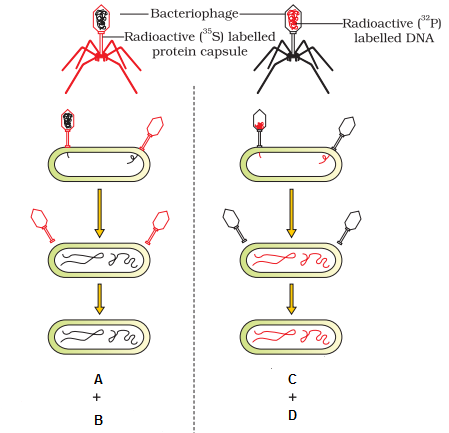My Notes
In Hershey and Chase experiment, what finding led to the conclusion that DNA is the genetic material ?
(1) The presence of radioactivity in the bacteria when 35S was used.
(2) The presence of radioactivity in the supernatant when 35S was used.
(3) The presence of radioactivity in the bacteria when 32P was used.
(4) The presence of radioactivity in the supernatant when 32P was used.
Which scientists first gave experimental evidence that DNA is the genetic material?
| 1. | Avery, MacLeod , and McCarty who repeated the transformation experiments of Griffith, and chemically characterized the transforming principle. |
| 2. | Garrod, who postulated that Alcaptonuria, or black urine disease, was due to a defective enzyme. |
| 3. | Beadle and Tatum, who used a mutational and biochemical analysis of the bread mold Neurospora to extablish a direct link between genes and enzymes. |
| 4. | Meselson and Stahl who showed that DNA is replicated semiconservatively. |
Alfred Hershey and Martha Chase made a big contribution in proving DNA role as the hereditary molecule. The experiment is shown in the diagram. A and C are the presence or absence of radioactivity detected in cells B and D are the presence or absence of radioactivity detected in supernatants cells. Identify A, B, C and D:

(a) A - No Radioactivity (35S) detected in cells; B - Radioactivity (32P) detected in supernatant; C - Radioactivity (35S) detected in cells; D - No Radioactivity in supernatant
(b) A- Radioactivity (35S) detected in cells; B - No Radioactivity (35S) detected in supernatant; C - Radioactivity (32P) detected in cells; D - No Radioactivity in supernatant
(c) A - No Radioactivity (35S) detected in cells; B - Radioactivity (35S) detected in supernatant; C - Radioactivity (32P) detected in cells; D - No Radioactivity in supernatant
(d) A - No Radioactivity (35S) detected in cells; B - Radioactivity (35S) detected in supernatant; C - No Radioactivity (32P) detected in cells; D - Radioactivity in supernatant
